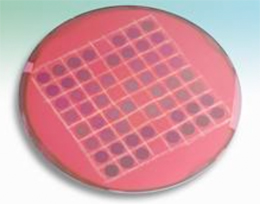Monday, April 13th, 2009
Intermolecular, the combinatorial R&D company that has been working on semiconductor fab processes, plans to grow solar R&D to possibly be the largest portion of the company’s business. Under the leadership of new vice president and general manager of solar business group Craig Hunter (who joined from Applied Materials), Intermolecular is now working on both silicon wafer and thin-film photovoltaic (PV) technologies. Surface texturing and various thin-film processes are the first immediate results shown.

Combinatorial materials experiment for thin-film silicon PV cells; 56 unique transparent conductive oxides (TCO) plus controls on single substrate (source: Intermolecular)
“The first thing we do in any engagement is cross-correlate between our lab and the tool that would be used in production,” explained Hunter in an exclusive interview with BetaSights. Since Intermolecular has been working on 45nm node IC process integration, the company’s tools are capable of extremely tight process control. Most PV lines use tools with far less process control, and so the greater inherent variability in PV tools is one factor in the design of experiments (DOE). Using 300mm diameter glass wafers for combinatorial materials experiments, a thin-film deposition tool can perform 56 unique transparent conductive oxide (TCO) experiments along with the needed control experiments on a single substrate (see figure).
Hunter explained that a recent solar customer had consulted with them about the specifications for a critical inline process tool. There was a given non-uniformity across the cell, but it was not known quantitatively what improvement in overall cell efficiency might be achieved with a reduced non-uniformity. Intermolecular was able to quantitatively predict the efficiency improvement that would result, allowing the customer to justify an increased tool cost.
There are inherently unique PV requirements for homes, businesses, and utilities. Even for utilities, different technologies are needed to meet the different demands for large PV farms, distributed roof-top collectors, and building-integrated PV (BIPV). “The end makets themselves are not uniform in requirements, so having a technology platform that can contribute to each of these markets is exciting,” explained Hunter. More about combinatorial materials R&D for PV in the next BetaSights Newsletter. –E.K.
